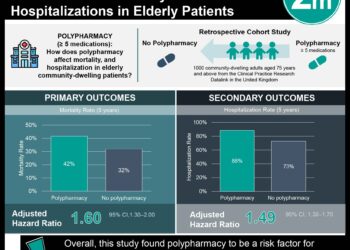Poor olfaction linked to increased mortality in older adults
1. In this prospective cohort study, poor olfaction was associated with mortality in older adults
2. Poor olfaction was an independent predictor of mortality, separate from neurodegenerative disease, poor baseline health, and weight loss.
Evidence Rating Level: 1 (Excellent)
Study Rundown: It is well established that sense of smell decreases as humans age. Previous studies have shown that olfactory impairment is a predictor of mortality, however no studies up until this point have stratified patients based on sex and health status. The authors of this prospective cohort study aimed to evaluate whether poor olfaction was a predictor of mortality separate from overall health status as well as potential explanations for why this might be. They found that poor olfaction was an independent predictor of mortality separate from baseline health, race, sex, and socioeconomic status. Among the potential mediators for why olfaction is associated with higher mortality, they found that weight loss, dementia, and Parkinson’s disease explained 30% of the higher mortality associated with poor olfaction, suggesting the majority of the poor health consequence related to poor olfaction are still unknown and warrant further explorant. This study was done on a large, well-established cohort with 13 years of follow up. The major limitation was that olfaction was only tested once at the beginning of the study and population was older individuals that had reasonable functional status, thus limiting the generalizability to younger or less functional older adults.
Click to read the study, published today in Annals of Internal Medicine
Relevant Reading: Olfactory identification deficits and increased mortality in the community
In-Depth [prospective cohort study]: The authors used the Health ABC (Health, Aging, and Body Composition) Study, which enrolled 3075 community-dwelling adults 70-79 years old living in Pittsburgh, Pennsylvania, and Memphis, Tennessee. Eligibility criteria included no difficulty in performing activities of daily living, no active cancer treatment, and no plan to leave the study area in the next 3 years. The 12-item Brief Smell Identification Test (BSIT) was administered to 2544 participants who attended the year 3 clinic. Additional exclusion criteria were participants who were missing data including BSIT, mediators, or were lost to followup. Participants with poor olfaction had a 46% higher risk for death at year 10 (risk ratio, 1.46 [95% CI, 1.27 to 1.67]) and a 30% higher risk at year 13 (risk ratio, 1.30 [CI, 1.18 to 1.42]) compared to those with good olfaction. Neurodegenerative diseases explained 22% and weight loss explained 6% of the higher mortality among participants with poor olfaction.
Image: PD
©2019 2 Minute Medicine, Inc. All rights reserved. No works may be reproduced without expressed written consent from 2 Minute Medicine, Inc. Inquire about licensing here. No article should be construed as medical advice and is not intended as such by the authors or by 2 Minute Medicine, Inc.



![siRNA against antithrombin alleviates symptoms of hemophilia [PreClinical]](https://www.2minutemedicine.com/wp-content/uploads/2015/04/clot-CCWiki-350x250.jpg)



